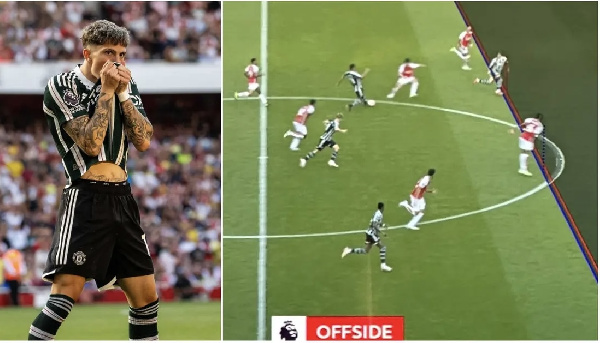How offside lines work on VAR after Garnacho is denied against Arsenal

It was a goal that could have handed Erik ten Hag’s charges three valuable points at the Emirates Stadium. Instead, the youngster was crestfallen after centre referee, Anthony Taylor was advised not to award the goal.
In another classic example of football cruelty, the hosts turned the heat on the Red Devils, scoring two stoppage-time goals to send the packed stadium into a delirium.
Such thin and tight were the margins between maximum points, a point, and no points for Manchester United, with ten Hag slamming a series of refereeing decisions.
“Many decisions went against us. I think Garnacho was onside, [Rasmus] Hojlund was fouled in the area and there was a clear and obvious foul on [Johnny] Evans for [Declan] Rice’s goal,” said the Dutch tactician, as quoted by talkSPORT.
From the naked eye, the re-instated Gabriel Magalhaes appeared to play Garnacho onside as Casemiro threaded the pass through.
However, after the blue and black lines were drawn, United fans were handed the dreaded red line and as former referee, Mike Dean said:
“Technology can’t put lines in the wrong place – that was offside.”
How exactly does this technology work? This weekend alone, there have been contentious offside decisions, particularly with a player interfering or blocking the goalkeeper’s eye line while behind the last defender.
Contentious offside decisions in Premier League
Nathan Ake’s goal – Manchester City’s second against Fulham – was so controversial that the Cottagers momentarily declined to restart play.
Manuel Akanji was clearly in an offside position as the Dutch defender sent the ball towards Bernd Leno’s goal. His teammate and hat-trick hero, Erling Haaland agreed with Fulham in a rare and honest assessment.
The same script was repeated on Sunday when Dominik Szoboszlai scored his first goal for Liverpool against Aston Villa. It was a beautiful volley by all definitions but was Salah in an offside position and obstructing Emiliano Martinez? Unai Emery thought so and Villa reportedly filed a complaint at half-time.
These two decisions, coupled with Garnacho’s disallowed goal, completely changed the result of the game.
One can argue that had Ake’s goal been ruled out, perhaps Fulham wouldn’t have conceded three more. Perhaps Villa wouldn’t have collapsed in the manner they did at Anfield. Perhaps United could have gotten a first Premier League victory at the Emirates Stadium since 2017.
According to the Premier League, the officials use the hawk-eye’s virtual offside line technology to arrive at decisions. This technology is broken down into the gridline and the crosshair.
The former is straightforward, with a line being drawn on the last defender. Any opposing player who is over the line headed towards the goal is deemed offside.
But at times, like in Garnacho’s case, the gridline fails to outrightly differentiate whether the attacking player is over the line or in a perfect and legal position – enter the crosshair.
Two one-pixel lines are drawn for the attacker and the defender. The lines are positioned on the parts of the player’s body that can be used to score goals. The body parts that are off the ground are shown by 3D virtual lines.
The attacking and defending lines are done manually before the VAR takes over and determines which line overlaps the other.
“The positioning of the crosshair is manual, with a line one-pixel wide, so that the exact position of the offside line and the relevant body part can be accurately identified by the VAR.”
Thicker lines were introduced at the start of this season, where the attacker was given the benefit of the doubt to eliminate the marginal of calls where perhaps only the toe was in an offside position.
The Premier League uses at least five calibrated cameras to determine the positions of the players and find the perfect angle to arrive at the correct decisions.
Jarred Gillet, the VAR official at the Emirates Stadium, worked through these lines and came to the conclusion that Garnacho had just strayed in an offside position.
For the Fulham and Aston Villa cases, the officials first determine if the player perceived to be influencing play is in an offside position. After that, it is under the referee’s discretion to rule if the said player is obstructing the goalkeeper or not.
And as far as such decisions go: today it will be given, tomorrow it will be rejected. What’s for certain, though, is that VAR draw is here with us to stay. Brace yourself, if you hadn’t, for more controversial decisions.
Source: www.sportsbrief.com





